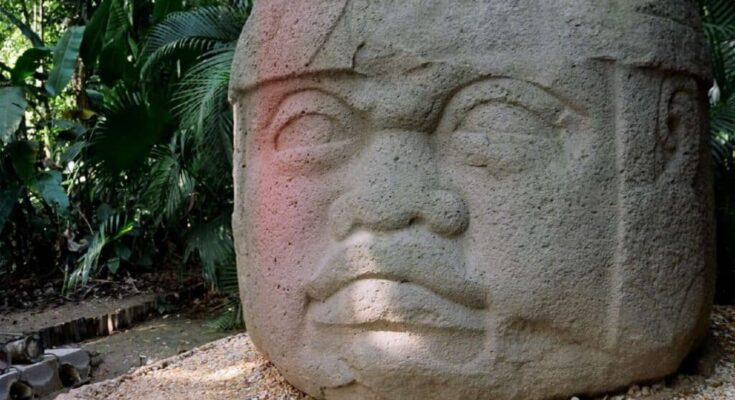
The Aztecs and the Mayans are the most well-known Mesoamerican civilizations, but, in fact, the Olmecs pre-existed them.
The Olmecs were the first of the great Mesoamerican civilizations. They lived along modern-day Mexico’s Gulf coast in what is today the states of Veracruz and Tabasco. The name Olmec, meaning rubber people, comes from the Aztec language of Nahuatl.
The reason behind the name is that the Olmecs may have been the first people to be able to use the latex of the rubber tree for something that could be hardened. Unfortunately, historians cannot be certain because the Olmecs didn’t leave behind much writing outside of some graphs and glyphs.
The Olmecs first appeared along Mexico’s Gulf coast around 1600 BC, but from about 1600 BC to 1200 BC, they are known as the pre-Olmec civilization. Once they settled in, the Olmecs thrived from about 1200 BC to 400 BC. Post-Olmec societies also exist, but they are separate from the era in which they flourished for eight hundred years.
Today, the Olmecs are known for the massive stone heads they left behind. The statues are made of basalt, a volcanic rock, and measure anywhere from four to eleven feet, depending on the statue. Archaeologists have also found evidence they were the first to start the Mesoamerican ballgame, played with a solid rubber ball.
The Olmec people and society
The Olmecs were prolific traders. They traded with other Mesoamerican civilizations, such as the Aztecs, and with settlements throughout modern-day Mexico. Evidence suggests they traded small figurines and masks, among other things, and received necessary materials such as cacao and salt.
Their civilization thrived because of their extensive trade networks. The Olmecs cemented themselves as a power along the coast and as a parent civilization for the later Mesoamerican civilizations.
Being a coastal civilization, they were also fond of fishing. While the lack of writings left behind means archaeologists and historians have to piece together what they can, it is clear they were a polytheistic society worshipping eight androgynous gods. Among their gods is the feathered serpent, whom the Aztecs would also worship when they arrived.
San Lorenzo and La Venta
From around 1200 to 900 BC, San Lorenzo thrived as one of the greatest cities in Mesoamerica. No one knows what the Olmecs called San Lorenzo, but this is the name that it has been given. Archaeologists have found many head statues and figures here, which has been key to giving them a glimpse into the Olmec civilization.
La Venta, not its original name either, was the city that took over San Lorenzo’s spot as the central city in Olmec civilization. It was a massive city for its time and potentially housed thousands of people. Thrones, the most prominent stone heads, and other vital art pieces have been found in La Venta.
Olmec Art
The Olmecs were known for their art. In addition to creating immense stone head statues, they sculpted anthropomorphic figures from jade, clay, basalt, and greenstone. The head statues were made of basalt, but the anthropomorphic figures were made of other materials.
The head statues date back to around 900 BC and are all in the shape of men with defined cheekbones. The statues are also cross-eyed, and some figures have cleft chins. Historians and archaeologists speculate that the statues could have depicted the different rulers of the civilization.
The fall of the Olmecs
The downfall of this incredible coastal civilization is a mystery. However, there are some speculations pertaining to this. Archaeologists believe the Olmecs’ downfall can be attributed to an environmental change that drastically lowered the water supply. This potentially affected irrigation, leaving people without drinkable water.
There is also a theory that sudden volcanic eruptions catalyzed the civilization’s dispersal throughout modern-day Mexico. Volcanos erupting in the area could have blanketed their cities in ash and volcanic debris, forcing them to new move on to new lands.



